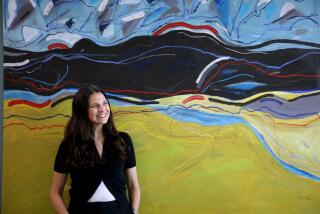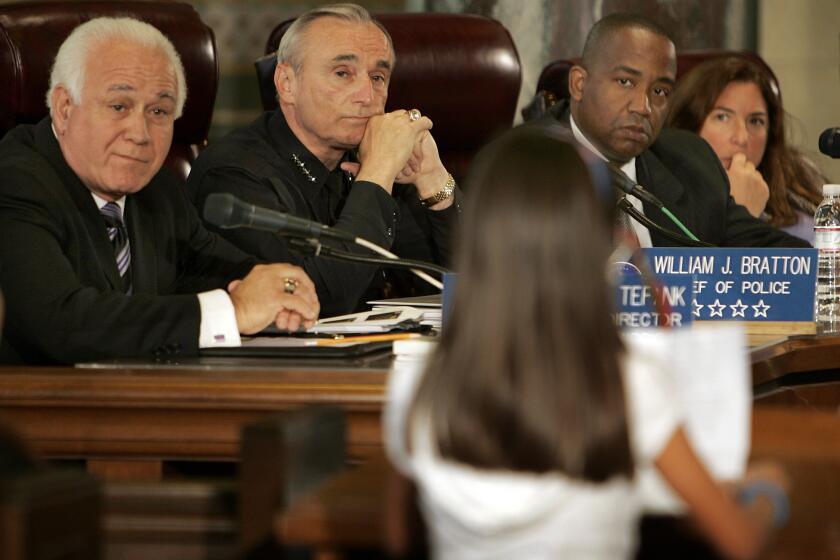Tall, Green, Vital: L.A. as Mayor Dreams It
There are at least two Los Angeles landscapes in the life of Mayor Antonio Villaraigosa.
There is real-life L.A., through which he hustles daily, running late by afternoon as the pictures and autographs, the abrazos and the press of eager constituents pile up. And then there is the Los Angeles of his imagination, the city whose outlines he hints at in speeches and whose details spill out when he settles in long enough to ruminate.
Villaraigosa’s imagined Los Angeles is denser, taller and greener than the city he now governs. High-rises dominate the skyline and hold not just offices but thousands of apartments, cleared for construction by zoning rules that encourage development of housing towers. The subway reaches west under Wilshire Boulevard, paid for with money Villaraigosa is convinced he can secure from the state and federal governments.
Islands -- villages, as he calls them -- sprout around subway stops and are ribboned together by swaths of green space, most notably along the Los Angeles River, where the mayor imagines trees and grass in place of the long segments of concrete culverts and channels that once carried runoff to the ocean. And all across that vast landscape, scores of pocket parks bring smatterings of green to even the densest urban neighborhoods.
Downtown is the heart of Villaraigosa’s future Los Angeles. It hums late into the night. The Civic Center is a sloping park surrounded by museums, restaurants and shops. New apartment buildings feature courtyards that offer public space during the day and protected enclaves at night. Some of the new buildings have small parks on the roofs, projects designed with energy efficiency in mind.
Not everyone believes in that future: Some argue that it’s not desirable; others say that even if it’s a worthy goal, it’s impractical. Villaraigosa argues that it’s not only compelling but something close to inevitable.
“This is going to happen,” he said last week in an interview at City Hall, where the mayor agreed to rhapsodize about the Los Angeles he believes possible. Even as he did, he displayed his characteristic impatience. He talked about subways and high-rises but interrupted himself to bounce around his office, gossiping and joking, riffing on the news, complaining that his staff does not schedule enough time for him to exercise, marveling at the story of Vice President Dick Cheney’s hunting accident.
On the topic of Los Angeles’ development, Villaraigosa emphasized that the city he imagines will come to pass only if it is carefully planned and pursued, starting now.
“We’re going to have,” he said, “stylish density,” “transit-oriented development,” “a sea change” of high-rise construction, a “string of emeralds” proposed decades ago but never adopted.
Buoyant and ebullient, Villaraigosa plowed through the time set aside to discuss the issue, pressing ahead while aides tried to flag him to the hour.
Interviewed separately, Robin Kramer, the mayor’s chief of staff, typically was both in agreement with her boss and more concise: “Density,” she said, “is not an enemy.”
Villaraigosa’s notions of what Los Angeles should look and feel like -- and of what a mayor’s job is in advancing that future -- represent his sharp break from his immediate predecessors.
Richard Riordan embraced a hybrid of neighborhood self-determination -- government, he liked to say, would not do anything for a community until the community banded together by itself -- and a belief in the galvanizing effects of big projects like Disney Hall, Staples Center and the new cathedral.
Riordan got those projects, and they succeeded much as he had hoped. But he chose not to articulate a comprehensive vision for the city’s physical development; that, he felt, was better left to neighborhoods.
James K. Hahn, who succeeded Riordan, was more of a maintenance mayor, concerned with fixing problems but shy about proposing a grand template.
If Villaraigosa’s version of the city’s future has a precedent, it lies a bit further back in Los Angeles’ history. As in many other aspects of his early administration, Villaraigosa picks up where Tom Bradley left off. Bradley, Los Angeles’ first black mayor and its chief executive from 1973 to 1993, was the mayor who built the subway and pushed Bunker Hill development, who envisioned downtown as the center of the metropolitan area; he did not always succeed, but he pushed for that vision during his five terms as mayor.
Villaraigosa tries to avoid comparing himself to Bradley -- he’s sensitive to Bradley’s gigantic place in Los Angeles history and wants to avoid direct comparisons, at least for the moment. But Villaraigosa does not mind it when others suggest similarities, and sometimes he can’t help himself. In his office last week, he squirmed in his chair at the mention of his illustrious predecessor. Bradley, said the mayor, told Los Angeles, “Let’s be a city with a purpose.” With that, Villaraigosa arched an eyebrow and gestured toward himself. His point: He too wants to lead with a purpose, and one notably reminiscent of Bradley’s, even if he does not quite like to say so.
Villaraigosa’s enthusiasm for the Los Angeles he believes in has many admirers in academia and beyond. Peter Dreier, director of the urban and environmental policy program at Occidental College, said he believes that Villaraigosa’s plans offer opportunities to expand housing for working-class people and to vitalize downtown. And he sees the chance to relieve traffic congestion and pollution at the same time.
The mayor, however, has not persuaded all his critics. Joel Kotkin, an educator and author who specializes in cities and writes frequently about Los Angeles, argues that Villaraigosa’s idea of the city is beguiling but impractical.
“That vision made sense during the 1970s,” he said, “when we all thought L.A. was going to be Manhattan West.”
Private industry, Kotkin predicted, will not deliver the buildings needed to fulfill Villaraigosa’s version of a modern Los Angeles, and without builders to make those investments, the mayor’s concept will be moribund. “I just don’t think the private sector will build that much,” Kotkin said, citing figures that show Los Angeles as static while the Inland Empire and Orange County grow more robustly.
Today, Kotkin said, high-rise construction is on the wane and Los Angeles is defined by an alternative urban landscape -- the single-family residential model that has structured the city’s growth since the turn of the last century. “You have to plan Los Angeles in accordance with the way L.A. was designed,” he said. Half of New York works in Manhattan, Kotkin notes; just 7% of Los Angeles works downtown. What works one place, he adds, will not necessarily work in the other.
Villaraigosa counters with his own statistics. A year ago, the mayor says, there were 26 high-rise projects on Los Angeles’ planning books. Two weeks ago, there were 51. And one week ago, there were 58. They stand at different stages of the long process: Five have received permits to build and 12 have submitted plans; others are at earlier, more tentative stages of development.
As for size, the smallest of the proposals is for an 11-story building while the tallest is a 58-story tower. Even if projects fall through, as Villaraigosa acknowledges many will, those that are built, he says, will help lay a foundation for a new skyline.
Still, the road ahead is complicated, and veterans of city politics warn that it will not be easy. Riordan supported Villaraigosa for mayor and likes his plans for the city, but government, Riordan warned, makes everything slower, more complicated and more costly. Imagining the future and achieving it, the former mayor emphasized, are vastly different.
Meanwhile, David Fleming, vice chairman of the Los Angeles Chamber of Commerce and a longtime San Fernando Valley activist, agrees that downtown deserves attention and investment but worries about centralizing too much.
“We have a lot of centers in the city of Los Angeles,” said Fleming, who favors a borough system that would spread out government offices and services. “We can’t put all our eggs in one basket.”
To transform his vision into a plan, Villaraigosa has hired Gail Goldberg, an urban planner whose tenure in San Diego has been lauded for its integration of neighborhood development with downtown expansion. Goldberg will soon assume her duties as Los Angeles’ planning director, and she argues that the city can have density along the lines that Villaraigosa espouses without compromising neighborhoods.
Under her tutelage, San Diego adopted a plan known as the “City of Villages,” in which priorities for downtown and the rest of the city were spelled out in detail after various communities met to discuss and harmonize their hopes for the future. Los Angeles, she said, may benefit from a similarly inclusive process.
“There has to be some coming together of citywide goals,” she said. “We have not focused on long-range planning in the past.”
Villaraigosa’s vision depends on money and cooperation, on help from Sacramento and Washington, and, perhaps most important, on a viable mass transportation system. There, too, his plans have proponents and skeptics. In last year’s mayoral campaign, Villaraigosa argued for the extension of the subway to the west, eventually reaching the ocean, though he didn’t give a time frame.
Estimates of that project’s cost range in the area of $4.8 billion, money the city does not have. Villaraigosa insists he can get it from Washington and Sacramento. The first step, he says, will be gaining a piece of California’s proposed infrastructure bond measure, which the governor and Legislature are debating. At the federal level, Villaraigosa has won an important concession, overcoming long-standing objections to the rail extension, but he still does not have new money in his pocket.
Again, Villaraigosa at first resisted the comparison to Bradley then jumped to embrace it. Bradley, he said, “ran in 1973 and said, ‘I’ll bring you a subway.’ He didn’t get it in four years. It took 20. And guess what? I’m going to bring us a subway too.”
As Villaraigosa talked, he glanced around his office, and his eyes settled on a piece of art. “Dream,” it reads. He pointed to it, walked over to it, moved aside an object that was obscuring it. That, he said, is the point, as it was for Bradley: to dream of a different kind of city and then to lead that city toward its future. “Dream, man,” he said. “You have to dream.”
Kotkin is dubious. “You turn L.A. into a bunch of apartment buildings,” he said, “and it’s more like Tehran than it is like Paris.”
More to Read
Start your day right
Sign up for Essential California for news, features and recommendations from the L.A. Times and beyond in your inbox six days a week.
You may occasionally receive promotional content from the Los Angeles Times.







